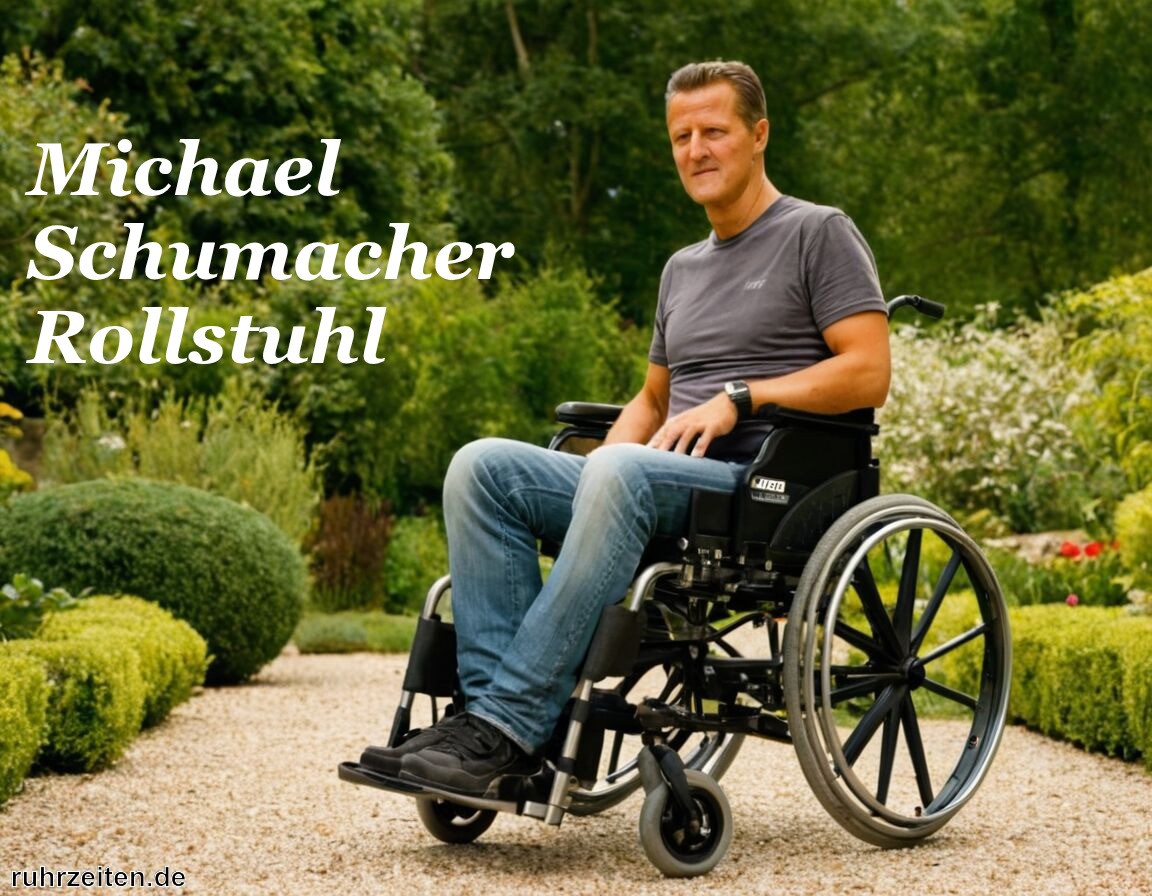Michael Schumacher Rollstuhl: The Silent Struggles of a Racing Legend

Introduction: A Legend Beyond the Racetrack
Michael Schumacher Rollstuhl is a name that echoes across the history of Formula 1. With seven world championships, over 90 Grand Prix victories, and an almost mythical presence on the racetrack, he is more than just a driver—he is a symbol of perfection, determination, and speed. However, beyond the roar of engines and the glitz of the podiums, lies a much quieter, more personal story. Since his tragic skiing accident in 2013, Schumacher has lived away from the spotlight, and the word “Rollstuhl” (German for “wheelchair”) has often been associated with him in media discussions.
The image of Schumacher in a wheelchair, whether accurate or speculative, has become symbolic of the dramatic shift in his life. From a man who once dominated some of the fastest cars in the world, to someone now dependent on medical care, the contrast has drawn global attention. But the fascination is not just about curiosity—it’s about empathy, respect, and a deep desire to understand how a global icon copes with such a life-changing event.
In this article, we’ll explore the story of Michael Schumacher Rollstuhl health journey, the role of the wheelchair in his recovery, and how the media and fans continue to interpret his situation.
Michael Schumacher Before the Accident

To understand the emotional weight behind the words “Michael Schumacher Rollstuhl”, one must first revisit his career. Schumacher was not just another driver; he was a phenomenon. His unmatched consistency, sharp instincts, and relentless training reshaped Formula 1. He introduced a level of professionalism and fitness that became the benchmark for future generations of drivers.
For over two decades, Michael Schumacher Rollstuhl life was defined by motion—speeding down straights at over 300 km/h, overtaking rivals with breathtaking precision, and pushing both his body and his machine to their absolute limits. Fans saw him as indestructible, a man whose willpower alone could conquer anything in his path.
That’s why the skiing accident in December 2013 felt almost surreal. If Michael Schumacher Rollstuhl could survive years of high-risk racing without a life-threatening injury, how could a simple ski trip alter everything? Yet, the tragedy served as a stark reminder that even the strongest among us are not immune to fate.
The Skiing Accident and Its Aftermath
On December 29, 2013, Michael Schumacher Rollstuhl was skiing with his son in the French Alps when he suffered a fall, striking his head on a rock despite wearing a helmet. The impact caused severe brain trauma, leading to an immediate medical emergency. He was rushed to Grenoble Hospital, where he underwent two major surgeries and was placed in a medically induced coma.
The world held its breath. News outlets across the globe provided constant updates, while fans gathered outside the hospital, holding banners and prayers for his recovery. Months passed, and though Schumacher eventually came out of the coma, it was clear that his life would never be the same again.
Reports about his condition have always been guarded, with the Michael Schumacher Rollstuhl family maintaining strict privacy. However, occasional information from close friends and insiders painted a picture of a man battling immense physical and neurological challenges. This is where the keyword “Rollstuhl” began entering public discourse, symbolizing not just physical limitations but also the heartbreaking contrast to Schumacher’s once vigorous, athletic lifestyle.
Michael Schumacher and the Wheelchair Image
The word “Michael Schumacher Rollstuhl” connected to Michael Schumacher has become almost a shorthand way for the public to imagine his current state. For many, it is difficult to visualize the legendary driver without the energy and charisma that defined him on the racetrack. Seeing or even imagining him in a wheelchair creates a strong emotional reaction—it makes the reality of his condition tangible.
Wheelchairs often carry a stigma of loss, weakness, or defeat. Yet, in Michael Schumacher Rollstuhl case, they should be viewed differently. A wheelchair does not define his legacy; it represents resilience. It represents a man who survived against all odds and continues to fight every single day with the support of his family, doctors, and fans.
Although Michael Schumacher Rollstuhl family rarely confirms specific details, reports from friends like Jean Todt (former Ferrari team principal) suggest that he spends much of his time at home in Switzerland, receiving round-the-clock care. The image of him in a wheelchair is not one of pity, but one of perseverance.
Media Coverage and Public Perception
The fascination with “Michael Schumacher Rollstuhl” also highlights the tension between public curiosity and family privacy. As one of the most famous athletes in the world, fans understandably want to know about his health. However, the Schumacher family has made it clear that his medical condition is private and not for public consumption.
Despite this, tabloids and news outlets continue to speculate, often publishing unverified reports or photos. This has sparked debates about ethics in journalism: how much does the public have a right to know about their heroes, and when does curiosity cross into intrusion?
What’s undeniable, though, is the sheer amount of support Schumacher continues to receive. Fans regularly post messages of encouragement online, organize tribute events, and create artwork to honor his legacy. The term “Michael Schumacher Rollstuhl” might appear cold in headlines, but for fans, it’s not about the chair—it’s about the man who sits in it, and the hope that one day he might regain more independence.
The Role of Family in His Recovery
Schumacher’s family has been his strongest pillar since the accident. His wife, Corinna Schumacher, has taken on the enormous responsibility of protecting his dignity while ensuring he receives the best possible medical care. She has often been praised for her strength and grace in handling such a delicate situation under global scrutiny.
His children, Mick and Gina, have also been crucial parts of this journey. Michael Schumacher Rollstuhl, following in his father’s footsteps, became a Formula 1 driver himself, carrying not just the Schumacher name but also the weight of immense expectations. Meanwhile, Gina has pursued equestrian sports, excelling in her own field while staying closely supportive of her father.
For them, the wheelchair is not a symbol of tragedy but of survival. It is a reminder that their husband and father is still with them, even if life looks very different now.
Michael Schumacher’s Legacy Beyond the Wheelchair
When people search for “Michael Schumacher Rollstuhl”, they often want to understand what has become of the racing icon. But it is important to remember that his legacy goes far beyond his current health struggles. Schumacher revolutionized Formula 1 in ways that remain visible today. His approach to fitness, his dedication to team collaboration, and his relentless pursuit of excellence set a standard that inspired generations of drivers.
Even in his absence from the public eye, Schumacher’s influence remains strong. His charity work, his role in shaping Ferrari’s golden era, and his mentorship to younger drivers continue to be celebrated. The wheelchair, in this context, does not diminish his greatness—it amplifies it, because it shows that even heroes face battles, and those battles only deepen the respect we feel for them.
Conclusion: A Hero Redefined
Michael Schumacher’s journey from world champion to a man living with severe health challenges is a story of contrasts—speed and stillness, triumph and struggle, public glory and private battles. The association with the word “Rollstuhl” may seem like a reduction of his identity, but in truth, it is part of a broader narrative about resilience, family, and the fragility of life.
While fans may never again see Schumacher walking down the paddock or stepping into a Formula 1 car, they continue to hold him in their hearts. His legacy as a driver is untouchable, and his courage in the face of adversity only strengthens his legend.
In the end, Michael Schumacher is not defined by the wheelchair—he is defined by his spirit. And that spirit, much like the roar of an F1 engine, will never fade.



